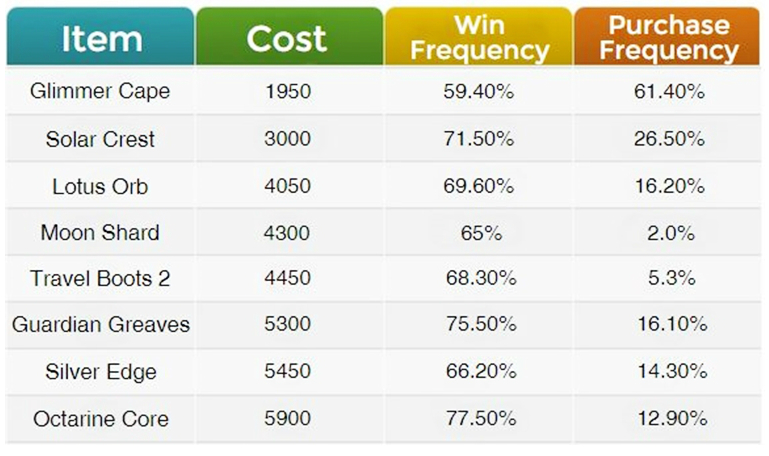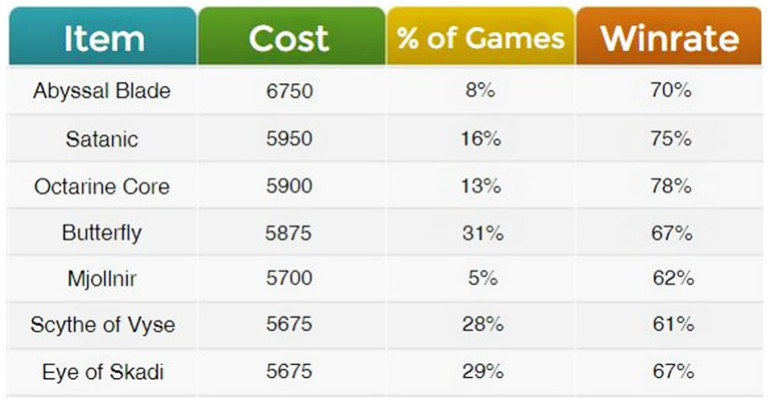Recently I was checking out at the grocery store, a full assortment of rice, pizza rolls, and various canned beans (you know – a balanced diet) ready to be paid for when I made a terrifying realization: I had forgotten my wallet. I had a $20 bill on me, and I had to filter down everything I wanted to buy into quite a bit less.
I realized Dota has prepared me for this. No thank you, real-life experiences, I’ll defer to your electronic counterpart and I’ll keep the pizza rolls.
What do I mean? Dota can be broken down into a few basic parts: control, execution, and economy. There is a physical limit to the amount of resources players can have in Dota. The peak is about 3000 end-game GPM for a team (only 10 teams have ever gone over that number, and never in against closely-ranked opponents). Teams typically achieve around 2000 GPM, meaning that teams typically have about 2000 gold per minute to spend on pizza rolls.
When 6.84 arrived, it brought a new inventory shipment to the Dota shops but did not bring economic growth. What this means is that while teams have about the same amount of money, they have more items to spend it on.
Like me at the grocery store, some items they would ideally be able to purchase must be left behind.
We haven’t seen a lot of analysis on what items are the losers of 6.84 and why. Let’s talk about which items are winners, which are losers, and the causes in 6.84’s Pro Dota scene.

Octarine Core
This item is an unmitigated success, and has had the second-largest impact of all the new items in Dota 6.84. Because it is a very expensive item, we would expect it to have a large winrate–after all, if you can afford it you are probably already winning. However, compared to any other item in the same cost class, Octarine Core has the highest winrate.
In addition, Octarine Core is picked up by at least one hero in 13% of games. Out of the 129 Octarine Core purchases made so far in pro dota, 71 have been on Leshrac. It’s easy to come to the reasonable conclusion that this item took Leshrac from a half-goat nobody to all-star equine basically overnight. There are other aspects to Leshrac’s sudden rise, but the Octarine Core is without a doubt one of the largest contributors to his popularity.

Octarine Core’s popularity seems to come largely at the expense of every other expensive item, especially Eye of Skadi which took huge hits as single-target right-click carries almost disappeared from the pro level. That money is being put into more Satanics, a large quantity of Octarine cores or Silver Edges, and sometimes a combination of less-expensive alternatives.
All we need now is a way to make it a core item on Mirana and Luna (Octarine is a fictional color which can only be seen by wizards and cats).
Silver Edge
This breaking blade has seen similar success to Octarine Core, with a slightly higher 15% purchase rate and a somewhat lower 66% winrate. However, Silver Edge has been knocking out several more expensive items, including Mjollnir, Abyssal Blade, and Daedalus.
The fact that it comes in relatively inexpensive chunks which scale out of the early game make it viable on offlane heroes or heroes playing from behind and provides survivability as well as punching power. Lost gold due to deaths makes items like Daedalus an unwise goal for heroes at risk of dying (especially ones without top farm priority) because of their high component cost, but Silver Edge is just right.
Glimmer Cape
The item so powerful it needed immediate subpatch nerfing, Glimmer Cape is clearly the most impactful new item to this patch. We see at least one Glimmer Cape in nearly every pro dota game with a 65% winrate when only one team in the game purchases it.
The item is also hugely versatile, with just about every support comfortably bearing the garment with ease, although it seems to shine particularly well on Witch Doctor due to the synergy with his ultimate. This hero’s rise in prevalence certainly owes something to the Glimmer Cape’s arrival.
This success has only been amplified by the increase in magic-based cores and decrease in right-clickers such as Juggernaut, Sniper, and Troll.
Euls Scepter, Force Staff, and Ghost Scepter are the most notable support items which took hits to open up the gold for Glimmer Cape, all of which are purchased in between 20 and 30% fewer pro games this patch.
Moon Shard
Nightstalker’s ownership of the midnight hour remains safe as Moon Shard is unequivocally the largest failure of the new stock. With only a 2% purchase rate and nearly half of those purchases on Tiny, Moon Shard didn’t exactly force any other items aside.
I could only find three instances of Moon Shard being consumed, putting the consumption rate at less than 15% the purchase rate. This item has definitely been hurt by the fact that games aren’t any longer (in fact, they are one minute shorter) on this patch.
Lotus Orb
Do you want to build a snowman? Lotus Orb’s notable interaction with Tusk’s snowball, along with other chaotic yet exciting interactions, has made it a fan favorite for highlight reels. The item itself has seen reasonable popularity in pro dota having been purchased in about 10% of games with a wild 70% winrate.
Like Octarine Core, this means that it outclasses every comparably priced item in efficacy (with the exception of Heaven’s Halberd), partly because it is only purchased when it is situationally strong (compared to Sange and Yasha, Orchid of Malevolence, Black King Bar, and Heaven’s Halberd which tend to be purchased as core items for a wide array of heroes).
Lotus Orb seems to be purchased at the expense of Linken’s Sphere, which is not at all surprising. The two items function similarly, but Lotus Orb provides much more teamfight and objective potential while Linkens Sphere provides more survivability alongside natural maneuverability. The problem is that high maneuverability isn’t that popular anymore, with the bulk of currently popular heroes lacking natural evasive skills and evasive items such as Blink Dagger, Phase Boots, and Force Staff losing popularity.
Solar Crest
Another support or semicore item which has seen solid popularity, Solar Crest lands as a mid-range priced item. With a staggering winrate of 72% and purchased in nearly 30% of games, Solar Crest has useful components for early game Roshan attempts. It is versatile starting very early in the game and accessible to a hero playing any position.
This appears to be at the expense of maneuvering items like Blink Dagger and Force Staff, both of which dropped huge amounts of prevalence this patch.
Guardian Greaves
Being honest, Guardian Greaves are not as popular as I expected them to be. Neither Mekansm nor Arcane Boots have dropped in end-of-game prevalence (in fact, they’ve grown), indicating that players aren’t often upgrading these items. It may be possible that losing teams are building toward Guardian Greaves but unable to reach the complete set, but unlikely because the winrate for the component items has fluctuated less than 2%.
Even so, the other blue boots are picked up in about 16% of games with a solid winrate. Since any hero purchasing this item would have already been likely to have purchased the components, the difference is only about 1650 in cost. That difference is taken out of the popularity of casual defensive or farming items including Hand of Midas or Mask of Madness.
How are those equivalent? Because as the metagame shifts away from heroes who maximize gains from Hand of Midas or Mask of Madness, teamfighting cores get more farm relative to their carries (we’re talking heroes like Dark Seer, Bristleback, and Undying).
Other Notable Trends in 6.84 Items
As I’ve mentioned several times, mobility is dropping in importance for the first time in recent memory. Blink Dagger is down 5%, Force Staff is down 8%, and Phase Boots are down 11%. This seems largely because teamfighting and grouped pushing are more prevalent, as is rat Dota. None of those strategies rely on highly mobile teams, but really require either one hero to initiate or one hero to be mobile enough to push alone.
Farm is more evenly distributed, meaning that mid-range items have seen a purchasing increase as supports have more money and carries have less money. The biggest winners this patch are all low-to-mid range items, including Drums of Endurance with a 12% increase, Helm of the Dominator with a 7% increase, and Desolator with a 6% increase. This also means that items for one type of hero are being traded in popularity for items for a totally different sort of role.
That being said, there is no significant relationship between the cost of an item and its change in popularity between patches.
This patch has also seen the death of the hard farmer, to some degree, with farming items including Battlefury, Maelstrom/Mjollnir, Mask of Madness, Hand of Midas, and Radiance all taking hits in popularity of at least 5% and no more than 30%.
A final note: teams have on average 30 GPM less than they did in 6.83 but are spending considerably more on items–I can only assume this is because buyback is less effective as a high-ground defense strategy and more teams are using their mid-game gold quickly as opposed to saving buyback as regularly, although I didn’t farm the data to test this hypothesis.
Featured Image: Nebula





3 Comments
QuiT
(26 comments)RIP Leshrac we won;t miss you, we have OD now…
April 8, 2016 at 9:32 am935ice
(969 comments)OD the new lesh!
April 16, 2016 at 12:44 pmKiop
(163 comments)lol^
April 19, 2016 at 8:44 pm